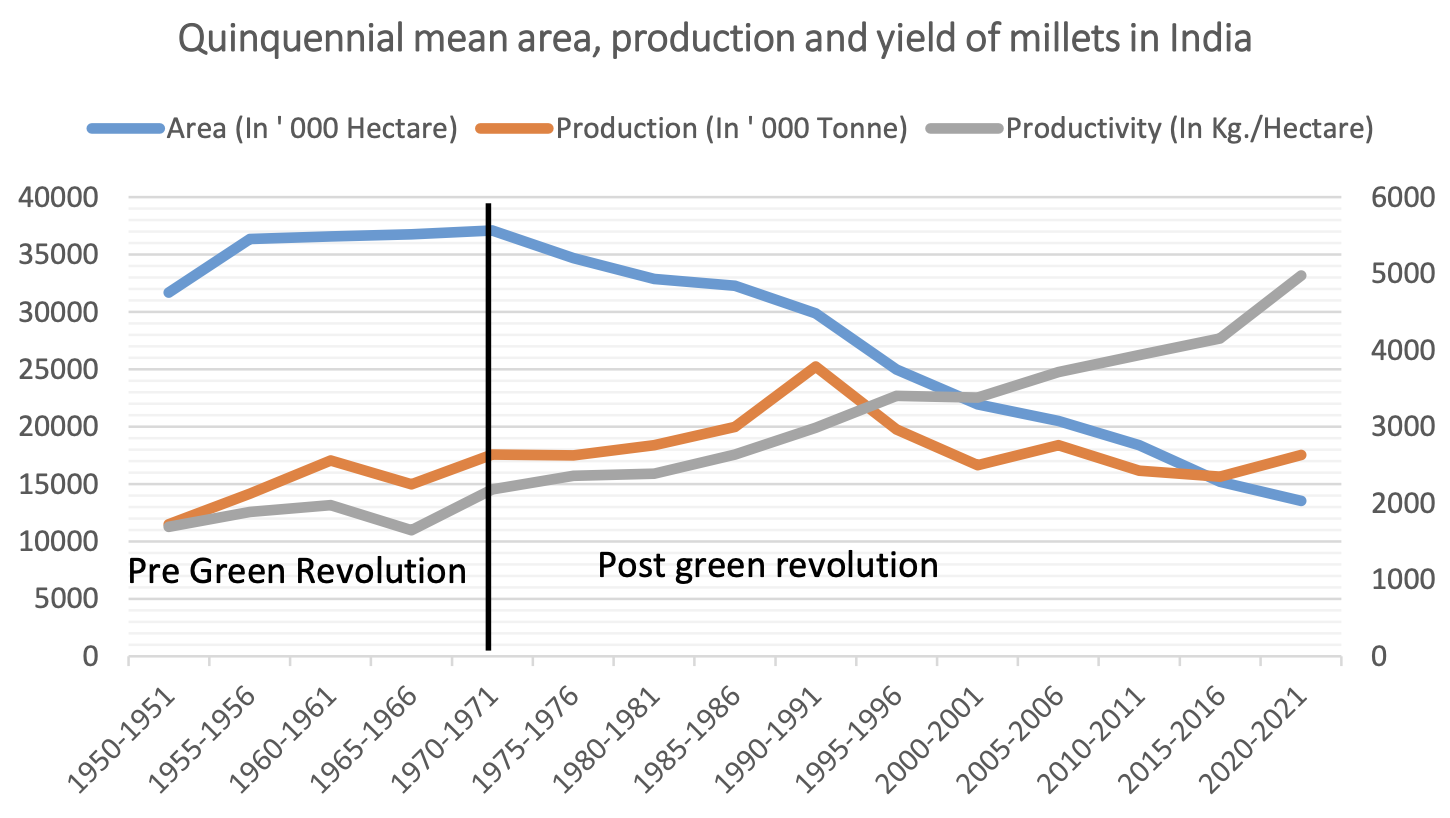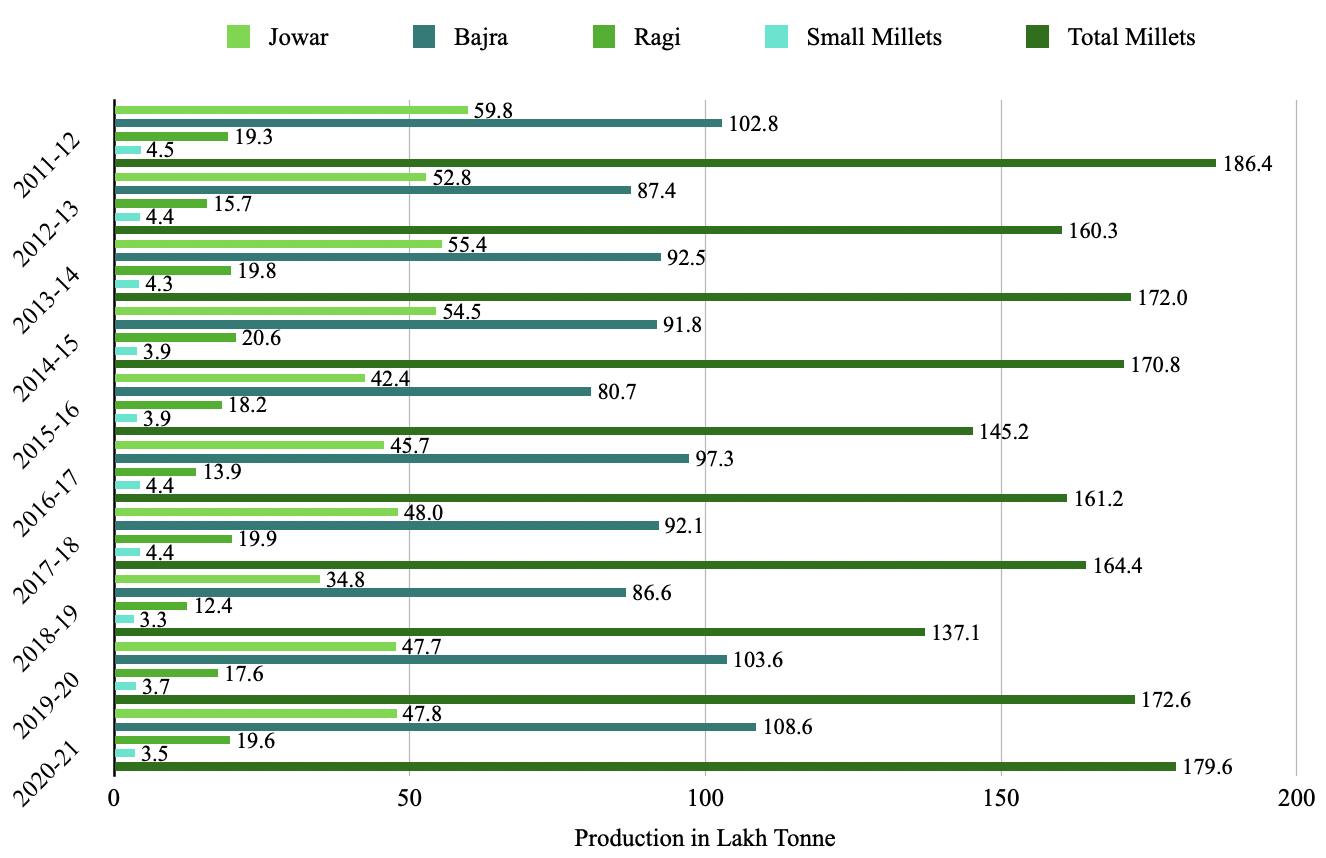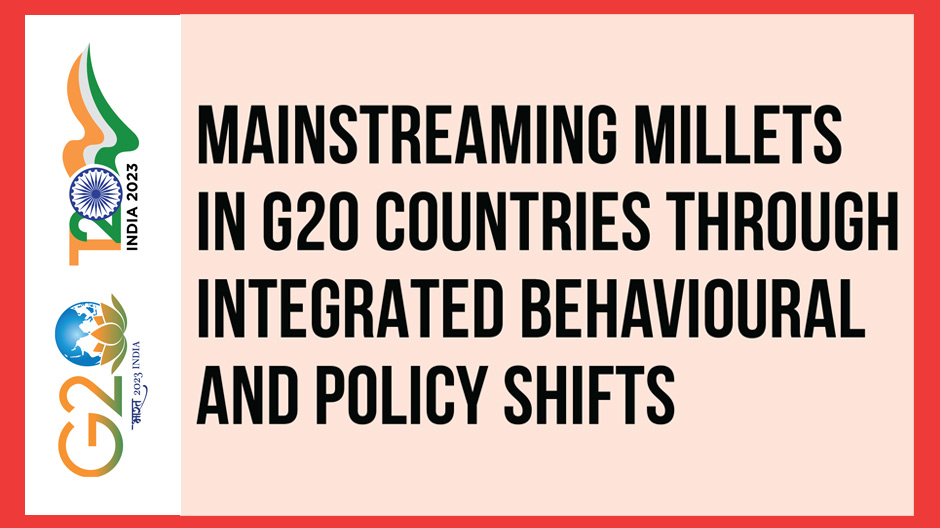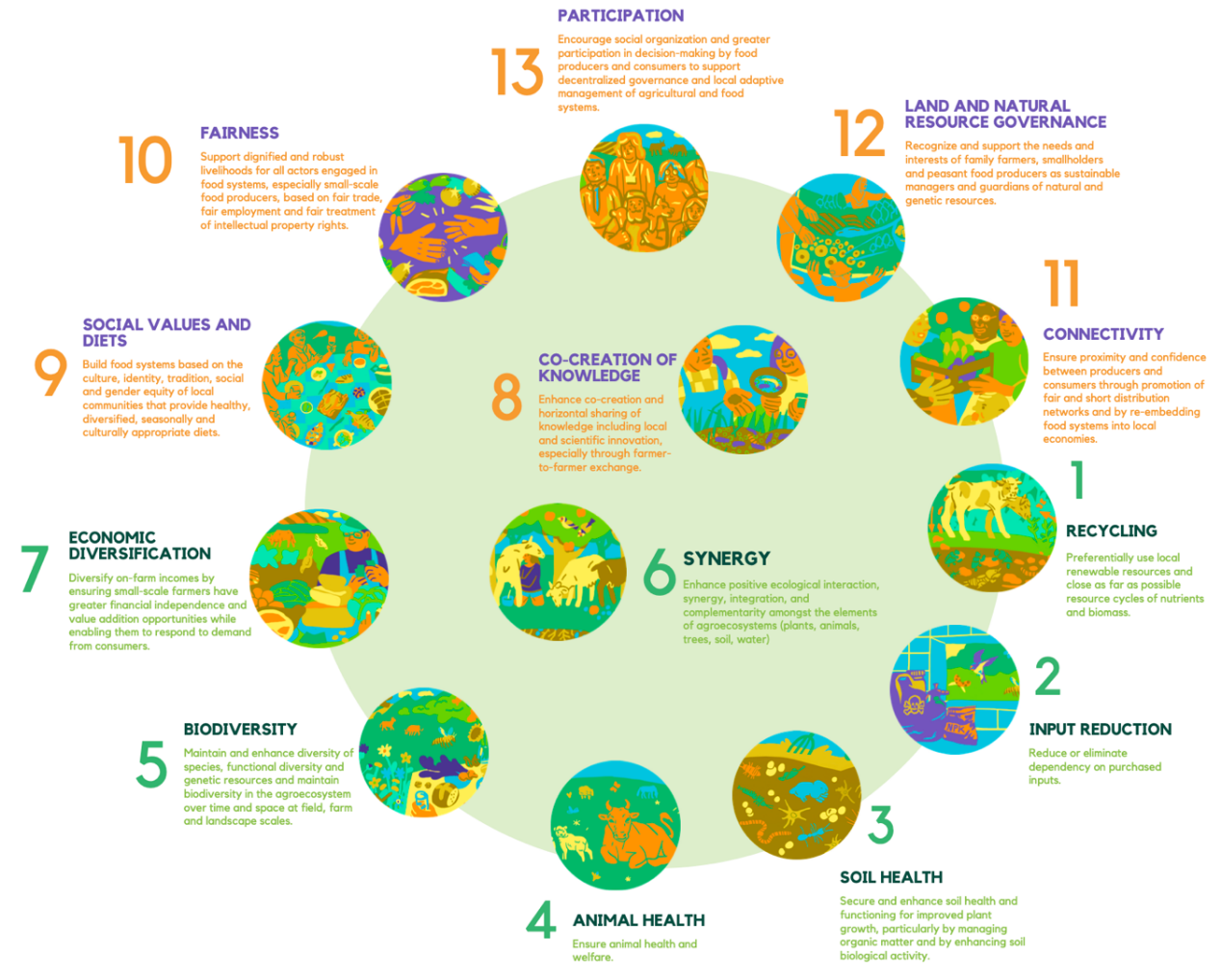Task Force 6: Accelerating SDGs: Exploring New Pathways to the 2030 Agenda
The United Nations General Assembly has declared 2023 as the International Year of Millets, a move proposed by India. During its G20 presidency, India can emerge as a global learning hub on millet production. This policy brief presents options to mainstream the production and consumption of millets in the G20 countries. It applies principles of agroecology and proposes the creation of farmers’ collectives to meet the supply-side challenges of mainstreaming millets. It further recommends behavioural interventions to overcome the demand-side challenges associated with mainstreaming the millets.
1. The Challenge
Millets are important crops for dry land farmers in India due to their highly nutritious aspects along with their resilience to climate risks. India is the largest producer of millets in the world and produces all nine millets, namely sorghum, pearl millet, finger millet, foxtail millet, proso millet, little millet, barnyard millet, browntop millet, and kodo millet. The major reasons for decreased consumption of millets are the lack of awareness of its nutritional metrics, inconveniences in food preparation, and the post-Green Revolution government policy of disincentivising millets while backing the supply of fine cereals at subsidised prices. Notably, prior to the Green Revolution, millets were an integral part of the Indian diet.
Figure 1: Quinquennial mean area, production, and yield of millets in India (1950-2021)

Source: Ministry of Agriculture & Farmers Welfare[1]
At present, with millets being grown in about 21 states, India is its largest producer in the world. With 173 lakh tonnes of millets production, India accounts for 80 percent of Asia’s millets production and 20 percent of the global production.[4] In India, the cultivated area of millets is 12.45 million hectares which produces 15.53 million tonnes with a yield of around 1247 kg/ha. It is interesting to note that India is the topmost producer of barnyard millet (99.9 percent), finger millet (53.3 percent), kodo millet (100 percent), little millet (100 percent), and pearl millet (44.5 percent), producing about 12.46 million metric tonnes from an area of 8.87 million ha.[5]
Figure 2: Millet production in India (2011-12 onwards)

Source: Author’s calculation based on data from Directorate of Economics and Statistics, Ministry of Agriculture[6]
Studies conducted by the Indian Council of Agricultural Research and Indian Institute of Millets Research have shown that in the case of millets like sorghum, finger millet, and pearl millet, the majority of the produce is used for self-consumption.[8] In terms of utilisation in the creation of value-added products in the fast-moving consumer goods (FMCG) segment, the percentage of all three are quite low.[9]
In the coming years, the use of millets as a direct food source is projected to resurface due to the growing health consciousness of the urban young populations. Additionally, a lot of start-ups and FMCG companies are developing culinary items based on millet, which are expected to draw more consumers in the upcoming years. This increase in demand in urban and semi-urban areas is anticipated to accelerate from 2019–20 to 2029–30 at a compound annual growth rate of 20.01 percent. The millet consumption is also estimated to increase with India’s initiatives under the International Year of Millets (IYoM) in 2023 where the government is looking to mainstream millets in the diets of its population across all states in India.
The IYoM has the potential to achieve the same for millets that the Green Revolution did for other cereals like rice and wheat, which propelled them onto our plates. The IYoM is also expected to have created positive externalities in the G20 countries in terms of sustainable agricultural practices and improved nutritional outcomes due to the adoption of millets.
2. The G20’s Role
Under India’s presidency, the G20 has emphasised the 3S strategy concerning food security—’smart’ and ‘sustainable’ agriculture that should ‘serve’ all, stressing the importance of the debate on global food security.[10] Multiple factors in the food system influence global environmental change. Due to food insecurity, many people are undernourished, suffer from a variety of non-communicable diseases linked to diet, or spend a large portion of their income on unbalanced diets.[11] During the meeting of agricultural chief scientists in April 2023, the Millets And Other Ancient Grains International Research Initiative was launched to further the objectives of the IYoM.[12] The G20 group has been exploring various means to address food security to which millets have emerged as a prominent answer. According to the International Crop Research Institute for the Semi-Arid Tropics, millets are a staple food for more than 90 million people in Asia and Africa.[13] In terms of millet import, a lot of G20 member countries contribute the largest shares such as Saudi Arabia, Belgium, Germany, and Italy, with Saudi Arabia being one of the top importers of millets from India. Going forward, the G20 countries should look to adopt crop diversification and introduction of millets in agriculture and dietary habits due to its various benefits (see Figure 3), which have been outlined below:
- growing demand for millets (out of the US$466.3 million in global imports in 2020, the top 10 importers accounted for US$221.7 million);
- lesser costs involved in farming millets; and
- millets provide greater nutritional value than rice and wheat which are water intensive.[14],[15]
Figure 3: Benefits of Millets

Source: Author’s compilation from Nutritional and Health benefits of Millets[16]
Table 1: Top Recipients of India’s Exports of Millets
| Country | 2019-20 | 2020-21 | ||||
| Qty In MT | INR Crore | US$ Mill | Qty In MT | INR Crore | US$ Mill | |
| Nepal | 15936 | 30.69 | 4.29 | 22095.7 | 45.07 | 6.09 |
| United Arab Emirates | 8407.7 | 22.15 | 3.1 | 15556.7 | 35.77 | 4.84 |
| Saudi Arabia | 10554 | 25.98 | 3.67 | 13516.5 | 28.62 | 3.84 |
| Libya | 3283 | 9.37 | 1.31 | 5142.63 | 12.19 | 1.65 |
| Tunisia | 5216 | 13.12 | 1.83 | 5549 | 12.1 | 1.63 |
| Morocco | 2652 | 6.73 | 0.94 | 3915 | 7.89 | 1.07 |
| UK | 1467 | 5.79 | 0.81 | 2102.85 | 7.34 | 0.99 |
| Yemen Republic | 4301 | 9.88 | 1.37 | 3138 | 5.79 | 0.78 |
| Oman | 976.19 | 2.6 | 0.37 | 2337.16 | 4.91 | 0.66 |
| Algeria | 1406 | 3.41 | 0.48 | 1761 | 3.65 | 0.49 |
| Total | 54200 | 129.72 | 18.17 | 75114.5 | 163.3 | 22.04 |
| Other Countries | 20,806 | 73 | 10 | 11,371 | 37 | 4.93 |
| Total | 75,006 | 203 | 28 | 86,486 | 200 | 26.97 |
| Share of top 10 in India’s export (in %) | 72.26 | 63.84 | 63.82 | 86.85 | 81.58 | 81.72 |
Source: DGCI&S, Metric Tonne (MT)[17]
3. Recommendations to the G20
This policy brief suggests three tools in this regard which are as follows:
Creation of farmers’ collectives and/or millets producing clusters
The US leads in millets exports, with a global share of around 30 percent.[18] With the global millet market projected to grow over US$12 billion by 2025, India must focus on its value-added chains to take advantage.[19] Significant processing and value-addition capacities are necessary for millets due to the coarse texture and flavour of the grains, which also make these processes expensive. Thus, better processing facilities can be located in developed nations which gives a country like the US a comparative advantage in the global export market. To benefit from the untapped potential for profits in the market for millets, stakeholders at all levels must become involved. This can be taken up in two ways:
Creation of farmers’ collectives and/or millets producing clusters (as made in Odisha) in states without a state-level millets mission: This would allow the small and marginal farmers aggregated under the collective to reduce their costs of production as the necessary inputs are procured in bulk and increase farm productivity and profitability. This also allows the farmers growing millets to enjoy economies of scale through produce aggregation, while accessing modern technologies which are relevant for processing millets.
Creating linkages between producers and the market: In the absence of these linkages, while millets are being procured at around INR 25-30/kg, the final price at the consumer’s doorstep is around INR 100-150/kg based on different levels of processing. Due to this, farmers still receive an insignificant portion of the consumers’ expenditure. These linkages can be created through millets tiffin centres and millets value hubs, which improve the linkages between farmers and markets.
Agroecology Principles
Mainstreaming the consumption of millets across G20 member countries will result in a corresponding increase in its demand and thus production. Therefore, mainstreaming the consumption of millets will generate co-benefits related to health and the environment. Through these environmental co-benefits, the cultivation of millets will lead to the furtherance of certain principles of agroecology. The principles of agroecology[20] are showcased in the following image.
Figure 5: Principles of Agroecology
The production of millets as water-efficient crops leads to the furtherance of agroecological principles through input reduction. Research has also found that cultivation of small millets (i.e finger millet, kodo millet, little millet, proso millet, and foxtail millet) leads to soil conservation. Foxtail millet is less nutrient-exhaustive, and the high root volume of finger millet allows it to hold more soil and thus prevent soil erosion. Thus, the production of millets leads to the furtherance of agroecological principles through the enhancement of soil health.Moreover, intercropping allows for furthering of the agroecological principle of biodiversity. Intercropping of millets along with paddy provides year-round ground cover, maximises water use efficiency, maintains soil fertility, and minimises soil erosion. Various cropping combinations like pearl millet-groundnut and millets-pulses can yield higher amounts along with efficient usage of resources.
To push for this, each G20 member country must develop a comprehensive plan to incorporate intercropping (utilising millets) to promote sustainable farming along with improved nutritional outcomes through crop diversity. Adoption of intercropping has been slow across Indian states as well. For instance, despite the success of the Odisha Millets Mission, millets have not been adopted as an intercrop as the mandate of the policy expected. India can scale up its adoption of millets as an intercrop while creating learning outcomes for other G20 member countries.
Farmers’ collectives and millets producing clusters will lead to economies of scale and shorten the distance between farmers and consumers. This will lead to furthering of agroecological principles of connectivity and participation while situating India as the centre of excellence for mainstreaming millets production and consumption.
Behavioural Interventions
Food habits are determined by multiple motives, directed and controlled by various stimuli. To create better awareness around millet consumption and change the behaviour of consumers to uptake millets as a healthier alternative, social and behavioural change communication (SBCC) activities should be used. Various studies have highlighted that the use of multiple platforms in delivering SBCC interventions can improve nutritional status.[23] The use of psychology and economics to change consumer preferences towards millets will allow the G20 member countries to create disproportionately large impacts with low-cost tweaks implemented during the IYoM. The goal of behavioural interventions should not be limited to altering the eating patterns of an individual in a particular context but generalising millet consumption to a regular home situation. Therefore, we propose a formulation of behavioural interventions through a combination of the socioecological health promotion framework[24] which identifies multiple, interdependent leverage points at policy, organisational, community, interpersonal, and intrapersonal levels, and the COM-B model of behaviour[25] that recognises the vital role of Capability (physical and psychological), Opportunity (physical and social), and Motivation to enact a behaviour more than any potentially competing behaviour on relevant occasions. These behaviour interventions can be divided into four levels of change as outlined below:
Level of Change: Intrapersonal: These strategies would be focused on targeting the individual characteristics that influence behaviour including attitudes, perspectives, and beliefs. This will increase the physical and psychological capabilities and motivation to consume millets. In India, studies have shown that the lack of incorporation of millets in regular eating practices is related to the lack of knowledge on how to cook them.[26] Hence, developing educational cooking programmes for cooking millets would ease the apprehensions related to it.
Various platforms of media to be leveraged to raise awareness about the health and environmental benefits of using millets and create a favourable attitude towards their consumption. Most importantly, individual awareness needs to be created about the quality of taste and liking since the perception of flavour is one of the most important aspects of dietary changes. Individuals usually model the choices of renowned personalities. Therefore, learning through modelling can be leveraged for mainstreaming millet consumption by creating millet ambassadors and targeted advertisement.
Level of Change: Interpersonal: These strategies would focus on interpersonal and group relations, which target social networks and social support and thereby increase social opportunity and motivation to consume millets. Observational learning and in-group dynamics can be used to promote change in the eating behaviour of an individual. Targeted interventions can be created for individuals that provide a point of access which can snowball into behavioural change. For example, children’s dietary preferences are considered important in urban households and hence provide us with a point of access to create change in households. Similarly, senior management at workplaces can provide a point of access to their employees and their eating patterns.
Level of Change: Organisational: These strategies would focus on organisational infrastructure, policies, and ethos and thereby increase physical opportunity and motivations that may promote millet consumption. Offering adapted lunches in schools, workplaces and commercial establishments would increase the exposure to the taste of millet-based dishes and create an opportunity for their consumption. Taste games and a participatory approach can be used, especially in schools, to develop active involvement in creating millet-based food and its taste experience. Free samples of millet-based products can be distributed at public events to increase exposure.
Level of Change: Community: These interventions are targeted at shared identities and relationships. These create increased social opportunities and motivations for millet incorporation. Consumption of millets can be linked to an individual’s social identity through community outreach programmes, advertising millets with emphasis on one’s regional identity, and creating a salient relationship between millets and one’s shared relationship.
Level of Change: Policy: These strategies focus on policies, advocacy, and structures that impact eating patterns so as to amply social opportunities for consumption of millets. Availability of millets in the market can be promoted with a simultaneous reduction in access to other grains that have lesser health benefits. Regulations targeted at the affordability of millets and affective nudges through additions in social welfare schemes like Targeted Public Distribution Systems, Pradhan Mantri Poshan Shakti Nirman, and Poshan 2.0 would increase individuals’ efficacy in choosing them.
The IYoM is expected to have a positive impact on the millets ecosystem. The IYoM can be a watershed moment in the history of millet production in India (like the Green Revolution was for wheat and rice). This is the best time to scale up millet production across states in India. However, its success will largely depend on the adoption of various behavioural interventions and agroecological principles which will ensure that millets adoption in India is sustained beyond the IYoM.
The Indian government launched seven sutras (principles) for IYoM: enhancement of production/productivity, nutrition and health benefits, value addition, processing, and recipe development, entrepreneurship/startup/collective development, awareness creation-branding, labelling and promotion, international outreach, and policy interventions for mainstreaming.
Mainstreaming of millets across G20 countries is expected to have significant health benefits. A disaggregation of the global disease burden shows that non-communicable diseases (NCDs) are responsible for 74 percent of all deaths globally,[27] which are influenced by genetic, physiological, environmental, and behavioural factors. If not arrested, this growing burden of NCDs threatens the achievement of Sustainable Development Goals.[28]. NCDs cost the global economy more than US$30 trillion over the 2011-2030 period.[29] About 70 percent of NCDs-related mortality occurs in 17 of the 19 G20 members.[30] Given these adverse impacts, G20 countries must work together on policies targeting modifiable behavioural risk factors. Mainstreaming of millets is one such policy, owing to their health benefits. Magnesium- and potassium-rich millets can help reduce blood pressure and reduce the risk of strokes and diabetes. They are highly nutritious due to their high fibre content that promotes slow digestion and gradual release of glucose into the bloodstream, which is beneficial in managing diabetes[31] and also lowers cholesterol.[32] The plant lignans, phenolic acids, tannins, and phytate present in millets protect against certain cancers.28 Therefore, by targeting the behavioural risk factor of an unhealthy diet, mainstreaming millets consumption will reduce the risk of NCDs, which is a huge burden for the G20 countries.
Attribution: Neel Lohit Pandey et al., “Mainstreaming Millets in G20 Countries Through Integrated Behavioural and Policy Shifts,” T20 Policy Brief, July 2023.
[1] “National Conference on Kharif Campaign, 2022,” Ministry of Agriculture and Farmers Welfare, last modified April 19, 2022.
[2] Joanna Kane-Potaka, Seetha Anitha, Takuji W. Tsusaka, Rosemary Botha, Muralidhar Budumuru, Shweta Upadhyay, Parkavi Kumar et al, “Assessing millets and sorghum consumption behavior in urban India: A large-scale survey,” Frontiers in Sustainable Food Systems 5 (2021): 680777.
[3] B. Dayakar Rao, Raj Bhandari, and Vilas A Tonapi, White Paper on Millets – A Policy Note on Mainstreaming Millets for Nutrition Security (Hyderabad: Indian Institute of Millets Research, 2021).
[4] “FAOSTAT,” Food and Agriculture Organization of the United Nations, accessed 2023.
[5] The Associated Chambers of Commerce and Industry of India, Knowledge Paper on Millets, (New Delhi: ASSOCHAM, 2022).
[6] “Advance Estimates of Food Grains, Oilseeds & Other Commercial Crops, 2011-21,” Directorate of Economics and Statistics, Ministry of Agriculture, accessed 2023.
[7] The Associated Chambers of Commerce and Industry of India, Knowledge Paper on Millets.
[8] B. Dayakar Rao, K. Bhaskarachary, G. D. Arlene Christina, G. Sudha Devi, and A. Tonapi Vilas, Nutritional and health benefits of millets (Hyderabad: Indian Institute of Millets Research, 2017).
[9] B Venkatesh Bhat, B Dayakar Rao and Vilas A Tonapi, The Story of Millets (Hyderabad: Indian Institute of Millets Research, Government of Karnataka, and Indian Council of Agricultural Research, 2018).
[10] “India Appeals to G20 Nations to Adopt ‘3S’ Formula in Agriculture for Tackling Food Security Concerns,” The Economic Times, last modified February 14, 2023.
[11] Polly Ericksen, Beth Stewart, Jane Dixon, David Barling, Philip Loring, Molly Anderson, and John Ingram, “The value of a food system approach,” Food security and global environmental change 25 (2010): 24-25.
[12] “India’s G20 Halfway Milestone,” G20 Secretariat, last modified May 2023.
[13] Sanjay Mohan Gupta, Sandeep Arora, Neelofar Mirza, Anjali Pande, Charu Lata, Swati Puranik, J. Kumar, and Anil Kumar, “Finger millet: a “certain” crop for an “uncertain” future and a solution to food insecurity and hidden hunger under stressful environments,” Frontiers in plant science 8 (2017): 643.
[14] “Exports of millets to increase exponentially as Indian exporters find new markets,” Ministry of Commerce & Industry, Government of India, PIB Delhi, last modified February 8, 2022.
[15] Shoba Suri, “Millet: The Super Food for Combating Food and Water Security,” Observer Research Foundation, April 6, 2022.
[16] Rao et al., Nutritional and health benefits of millets.
[17] PIB Delhi, “Exports of millets to increase exponentially as Indian exporters find new markets.”
[18]Ayushi Baloni and Ashutosh Choudhary, “The Global Impact Economy of Millets,” Impact Entrepreneur, January 26, 2022.
[19] Baloni et al., “The Global Impact Economy of Millets.”
[20] Alexander Wezel, Stéphane Bellon, Thierry Doré, Charles Francis, Dominique Vallod, and Christophe David, “Agroecology as a science, a movement and a practice. A review,” Agronomy for sustainable development 29 (2009): 503-515.
[21] Évariste Nicolétis, Patrick Caron, Mahmoud El Solh, Martin Cole, Louise O. Fresco, Alex Godoy-Faúndez, Maria Kadleciková et al, Agroecological and other innovative approaches for sustainable agriculture and food systems that enhance food security and nutrition (HLPE, 2019).
[22] Stephen R. Gliessman, Package price agroecology: The ecology of sustainable food systems (CRC press, 2021).
[23] Purnima Menon, Marie T. Ruel, Phuong H. Nguyen, Sunny S. Kim, Karin Lapping, Edward A. Frongillo, and Silvia Alayon, “Lessons from using cluster-randomized evaluations to build evidence on large-scale nutrition behavior change interventions,” World Development 127 (2020): 104816.
[24] Kenneth R. McLeroy, Daniel Bibeau, Allan Steckler, and Karen Glanz, “An ecological perspective on health promotion programs,” Health education quarterly 15, no. 4 (1988): 351-377.
[25] Susan Michie, Maartje M. Van Stralen, and Robert West, “The behaviour change wheel: a new method for characterising and designing behaviour change interventions,” Implementation science 6, no. 1 (2011): 1-12.
[26] Joanna Kane-Potaka, Seetha Anitha, Takuji W. Tsusaka, Rosemary Botha, Muralidhar Budumuru, Shweta Upadhyay, Parkavi Kumar et al., “Assessing millets and sorghum consumption behavior in urban India: A large-scale survey,” Frontiers in Sustainable Food Systems 5 (2021): 680777.
[27] “Noncommunicable diseases,” World Health Organisation, last modified September 2022.
[28] “SDG Target 3.4,” World Health Organisation, accessed 2023.
[29] “Economics of NCDs,” Pan American Health Organisation, accessed 2023.
[30] World Health Organisation, Non-Communicable Diseases Country Profiles 2014 (Geneva: World Health Organization, 2014).
[31] Lilian U Thompson, “Potential health benefits and problems associated with antinutrients in foods,” Food Research International 26, no. 2 (1993): 131-149.
[32] Rao et al., Nutritional and health benefits of millets.






